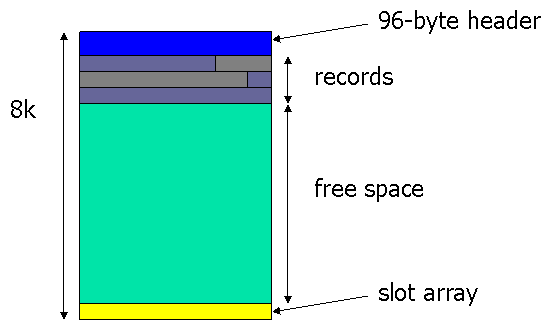
Header
The page header is 96 bytes long. What I’d like to do in this section is take an example page header dump from DBCC PAGE and explain what all the fields mean. I’m using the database from the page split post and I’ve snipped off the rest of the DBCC PAGE output.
DBCC TRACEON (3604)Note that I didn’t include the fields starting with Metadata:. That’s because they’re not part of a page header. During SQL Server 2005 development I did some major work rewriting the guts of DBCC PAGE and to save everyone using it from having to do all the system table lookups to determine what the actual object and index IDs are, I changed DBCC PAGE to do them internally and output the results.
DBCC PAGE (‘pagesplittest’, 1, 143, 1);
GO
m_pageId = (1:143) m_headerVersion = 1 m_type = 1
m_typeFlagBits = 0x4 m_level = 0 m_flagBits = 0x200
m_objId (AllocUnitId.idObj) = 68 m_indexId (AllocUnitId.idInd) = 256
Metadata: AllocUnitId = 72057594042384384
Metadata: PartitionId = 72057594038386688 Metadata: IndexId = 1
Metadata: ObjectId = 2073058421 m_prevPage = (0:0) m_nextPage = (1:154)
pminlen = 8 m_slotCnt = 4 m_freeCnt = 4420
m_freeData = 4681 m_reservedCnt = 0 m_lsn = (18:116:25)
m_xactReserved = 0 m_xdesId = (0:0) m_ghostRecCnt = 0
m_tornBits = 1333613242
Here’s what all the fields mean (note that the fields aren’t quite stored in this order on the page):
- 18 – a page that’s be deallocated by DBCC CHECKDB during a repair operation.
- 19 – the temporary page that ALTER INDEX … REORGANIZE (or DBCC INDEXDEFRAG) uses when working on an index.
- 20 – a page pre-allocated as part of a bulk load operation, which will eventually be formatted as a ‘real’ page.
- m_indexId
Records
See this blog post for details.
Slot Array
It’s a very common misconception that records within a page are always stored in logical order. This is not true. There is another misconception that all the free-space in a page is always maintained in one contiguous chunk. This also is not true. (Yes, the image above shows the free space in one chunk and that very often is the case for pages that are being filled gradually.)If a record is deleted from a page, everything remaining on the page is not suddenly compacted – inserters pay the cost of compaction when its necessary, not deleters.Consider a completely full page – this means that record deletions cause free space holes within the page. If a new record needs to be inserted onto the page, and one of the holes is big enough to squeeze the record into, why go to the bother of comapcting it? Just stick the record in and carry on. What if the record should logically have come at the end of all other records on the page, but we’ve just inserted it in the middle – doesn’t that screw things up somewhat?No, because the slot array is ordered and gets reshuffled as records are inserted and deleted from pages. As long as the first slot array entry points to the logically first record on the page, everything’s fine. Each slot entry is just a two-byte pointer into the page – so its far more efficient to manipulate the slot array than it is to manipulate a bunch of records on the page. Only when we know there’s enough free space contained within the page to fit in a record, but its spread about the page do we compact the records on the page to make the free space into a contiguous chunk.One interesting fact is that the slot array grows backwards from the end of the page, so the free space is squeezed from the top by new rows, and from the bottom by the slot array.
Nenhum comentário:
Postar um comentário